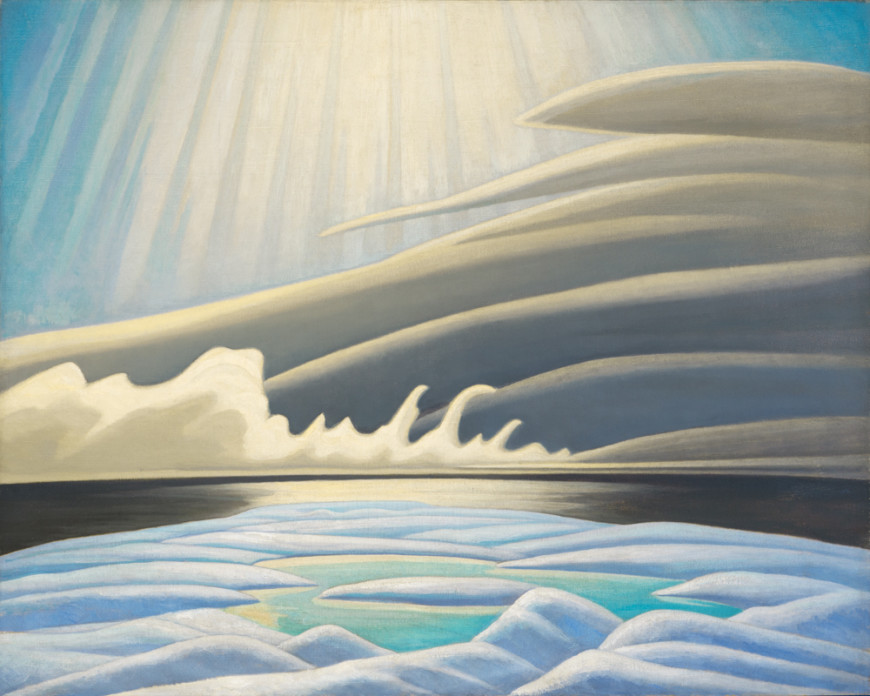-
Œuvres d'art
Lawren S. HarrisSun, Fog and Ice, Smith Sound (Arctic Painting IV), 19311885-1970Oil on canvas40 x 50 in
101.6 x 127 cmSoldProvenance
Artist;
Fine Art Galleries T. Eaton Co. College Street, Toronto, 1953.
Private collection, Toronto.
Roland Dumais, Montreal.
Christie’s in Canada, 14 Oct. 1971, lot 72, Montreal.
Galerie Walter Klinkhoff Inc., Montreal;
Acquired from the above by Mitzi and Mel Dobrin.
Expositions
Toronto, Art Gallery of Toronto, May 1931, Arctic Sketches by Lawren Harris and A.Y. Jackson, R.C.A, no. 390 as Sun, Fog and Ice, Smith Sound.
Vancouver, Vancouver Exhibition, Exhibition of Paintings and Photography, Sketches of the Canadian North by Lawren Harris, R.C.A. [sic] and A.Y. Jackson, R.C.A., August 22 - August 29, 1931, no. 317 as Fog and Ice, South [sic] Sound.
Toronto, Art Gallery of Toronto, Exhibition by the Group of Seven, no. 64 as Sun, Fog and Ice, Smith Sound $750.
Toronto, Canadian National Exhibition, 25 August - 9 September 1939, no. 95 as Sun, Fog and Ice, Smith Sound.
Toronto, Canadian National Exhibition, 25 August – 9 September 1950, no. 150 as Sun, Fog and Ice, Smith Sound oil on canvas 40 x 50, Lent by the artist.
Toronto, Alan Klinkhoff Gallery, Lawren Harris & Canadian Masters: Historic Sale Celebrating Canada's 150 Years, April 1 - April 30, 2017.Documentation
E.W. Harrold, “Seventh Group of Seven Show,” The Morning Citizen (Ottawa: 29 December 1931).
The paintings of Lawren Harris compiled by Mrs. Gordon Mills, July-December 1936 as Arctic Paintings, no. 4.
Jeremy Adamson, Urban Scenes and Wilderness Landscapes (Toronto: Art Gallery of Ontario, 1978), pp. 190-195.
In August and September 1930 Lawren Harris travelled to the Arctic with A.Y. Jackson on the government supply boat, the S.S. Beothic. The ship went directly north to Godhaven on the Greenland coast, and then up the coast through Smith Sound to Etah and into Kane Basin, along the coast of Ellesmere Island to Lancaster Sound, around the top of Baffin Island, down the east coast to Hudson Bay and Chesterfield Inlet, then southward along the Labrador Coast to Nova Scotia. As Harris wrote in 1948, “While we were on this trip Jackson and I painted a large number of sketches, although painting was difficult as we usually saw the most exciting subjects while steaming through channels or while being bumped by pack ice. On many occasions we had to take rapid notes. These notes we worked up into sketches, crowded in our small cabin, seated on the edge of our respective bunks with only a port-hole to let in the light.”
In spite of the difficulties, the trip was very productive and Harris exhibited thirty Arctic sketches in a joint exhibition with Jackson at the National Gallery in December 1930. (Thirty-eight Arctic sketches were inventoried in 1936). By the time they showed their Arctic work at the Art Gallery of Toronto in May 1931 Harris had already painted six canvases, including Sun, Fog and Ice, Smith Sound.
The subjects of Harris’ Arctic canvases include floating icebergs or coastlines and mountains viewed from off shore. The effects of colour and light range from drab browns and greys to blues and off whites, to evocative studies of the effects of sun and ice as in this canvas painted from a sketch acquired by his friend, the Toronto collector Charles S. Band (fig. 1). Harris remained faithful to the sketch in working up the canvas. The ice and pool of water in the foreground, the open sea beyond, the dramatic movement of the fog rising from the water, the almost three-dimensional pointed clouds moving in from the right and the spotlight effect of sun rays emerging from the sky appear in both. But he has enlarged the height to conform to the proportions of the canvas and thereby increasing the illumination in what must be the most lyrical and animated of all Harris’ Arctic paintings.
When exhibited in the December 1931 Group of Seven exhibition, E.W. Harrold wrote in the Ottawa Citizen, “The most striking work is still being done by Lawren Harris. Seven years ago, Harris startled the art world with his ‘Above Lake Superior.’ In this Harris threw tradition to the wind. He did not paint a specific stretch of country so much as a summing up of a whole region… Marvellous light effects are obtained in … “Sun, Fog and Ice, Smith Sound.” This picture mocks all our preconceptions of Arctic scenery. Here is no drab desolation but lights and surfaces that play against each other in the most enlivening way. The conception is vastly original. Again this is not a locality, but the sum of locality.”
In 1953 this painting was acquired by the couple who had purchased Lawren Harris’ house at 2 Ava Crescent, designed in 1931 by Alexandra Biriukova. The canvas would have been a remarkable complement to the restrained yet lush severity of the house’s Art Deco interior.
By Charles C. Hill, C.M.1sur 2





